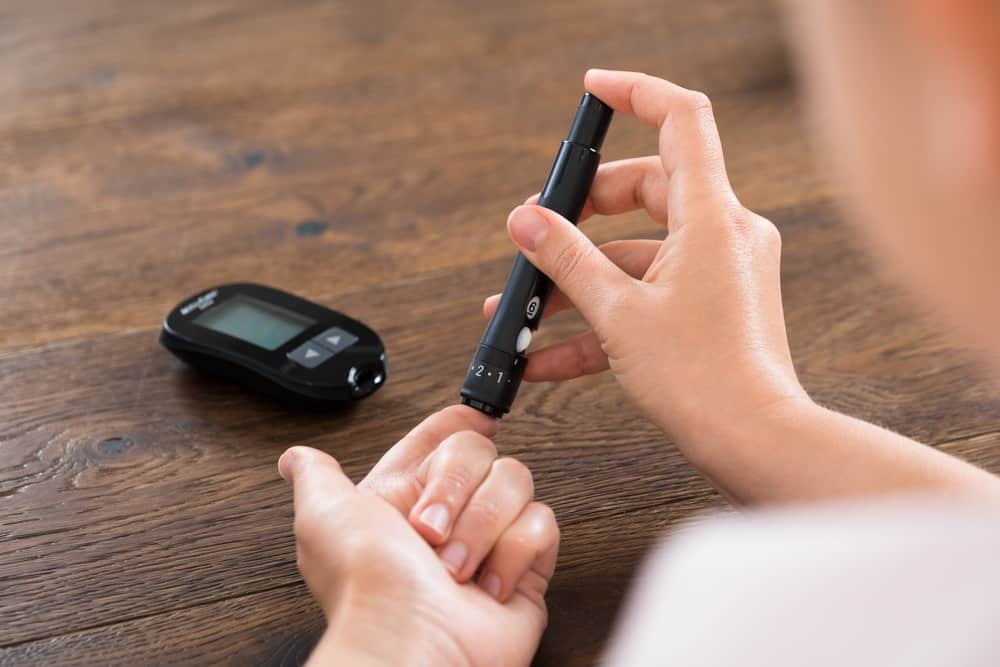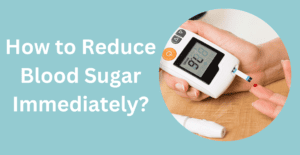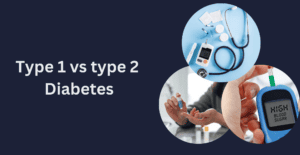Hyperglycemia is a condition characterized by elevated levels of glucose (sugar) in the blood. This can occur in individuals with and without diabetes and can have serious health consequences if left untreated. Hyperglycemia meaning is caused by a combination of factors, including diet, physical activity, stress, and medication use. The Symptoms of Diabetes or high blood sugar symptoms of hyperglycemia(high sugar symptoms/hyperglycemia symptoms) can range from mild to severe and may include increased thirst, frequent urination, fatigue, blurred vision, and slow healing of cuts or infections. Diabetes Treatment of hyperglycemia(hyperglycemia treatment) may include lifestyle changes, such as changes in diet and physical activity, as well as the use of medications or insulin therapy, depending on the severity and underlying cause of hyperglycemia. Effective prevention of what is hyperglycemia can be achieved by making lifestyle changes, monitoring blood sugar levels regularly(what is normal blood sugar level), and working closely with a healthcare professional or a registered dietitian.
What is Hyperglycemia? – High Blood Sugar
Hyperglycemia is a medical term used to describe high blood sugar or high levels of glucose in the bloodstream. Normally, the hormone insulin regulates the level of glucose in the blood by helping to transport it into cells for energy. However, when the body is unable to produce enough insulin or is resistant to its effects, blood sugar levels can rise(what is normal blood sugar level), leading to hyperglycemia meaning(what is hyperglycemia). This can occur in individuals with and without diabetes and can be a result of various factors, such as an unhealthy diet, physical inactivity, stress, illness, and certain medications. If left untreated, hyperglycemia can lead to serious health complications, such as damage to the eyes, kidneys, nerves, and blood vessels. It is important to monitor blood sugar levels(what is normal blood sugar level) regularly and work closely with a healthcare professional to learn about Diabetes Management and prevent what is hyperglycemia.
What causes hyperglycemia? What causes hyperglycemia in people with diabetes?
Hyperglycemia can be caused by a variety of factors, including:
- Diet: Consuming high amounts of sugary or refined carbohydrates can cause blood sugar levels to rise rapidly.
- Physical inactivity: Lack of physical activity can lead to decreased insulin sensitivity and increased glucose production by the liver, leading to high blood sugar levels.
- Stress: Stressful events can increase the release of hormones, such as cortisol and adrenaline, which can cause the liver to produce more glucose and the muscles to use less glucose, leading to high blood sugar levels.
- Medications: Certain medications, such as corticosteroids, can increase glucose production and reduce insulin sensitivity, leading to hyperglycemia.
For individuals with diabetes, hyperglycemia meaning(what is hyperglycemia) is caused by an imbalance between insulin and glucose in the bloodstream. In type 1 diabetes, the body is unable to produce enough insulin, leading to high blood sugar levels. In type 2 diabetes, the body becomes resistant to insulin, leading to elevated glucose levels in the bloodstream. Other factors, such as illness, stress, and changes in diet and physical activity can also contribute to hyperglycemia in individuals with diabetes.
It is important to monitor blood sugar levels regularly(what is normal blood sugar level) and work closely with a healthcare professional to effectively manage and prevent what is hyperglycemia.
Other Possible Causes
In addition to the factors mentioned above, other possible causes of hyperglycemia include:
- Illness: Certain illnesses, such as infections or urinary tract infections, can cause the body to produce more glucose, leading to high blood sugar levels(what is normal blood sugar level).
- Hormonal imbalances: Hormonal imbalances, such as those seen in conditions like Cushing’s syndrome or pheochromocytoma, can cause the body to produce more glucose, leading to hyperglycemia.
- Alcohol consumption: Consuming large amounts of alcohol can interfere with the liver’s ability to regulate glucose levels and can cause blood sugar levels(what is normal blood sugar level) to rise.
- Skipping or delaying meals: Skipping meals or delaying them can cause the liver to produce more glucose and the muscles to use less glucose, leading to high blood sugar levels(what is normal blood sugar level).
- Certain medical conditions: Certain medical conditions, such as pancreatitis or liver disease, can interfere with the regulation of glucose levels and lead to hyperglycemia.
What are the symptoms of hyperglycemia?
Early signs and symptoms
Early signs and high blood sugar symptoms of hyperglycemia(high sugar symptoms/hyperglycemia symptoms) include:
- Increased thirst: As the body tries to rid itself of excess glucose, it may cause increased thirst.
- Frequent urination: As the body produces more insulin to manage high blood sugar levels, it may lead to frequent urination.
- Fatigue: Hyperglycemia can cause the body to feel tired and weak as glucose is not effectively being used for energy.
- Blurred vision: High blood sugar levels can cause fluid to be pulled from the lenses of the eyes, leading to blurred vision.
- Headaches: High blood sugar levels can cause headaches and changes in mood.
- Increased hunger: The body’s cells may not be able to effectively use glucose for energy, leading to increased hunger.
- Dry mouth and skin: As the body tries to rid itself of excess glucose through frequent urination, it can lead to dehydration and dry mouth and skin.
Later signs and symptoms
Later signs and high blood sugar symptoms of hyperglycemia(high sugar symptoms/hyperglycemia symptoms) can include:
- Slow-healing cuts or wounds: High blood sugar levels can interfere with the normal healing process of the body.
- Numbness or tingling in hands and feet: Over time, high blood sugar levels can damage the nerves, leading to numbness or tingling in the hands and feet.
- Yeast infections: High blood sugar levels can provide an environment for the growth of yeast and other fungi.
- Weight loss: Despite increased hunger, high blood sugar levels can cause weight loss as the body breaks down fat and muscle for energy.
- Confusion, drowsiness, and blurred vision: Severe hyperglycemia can cause confusion, drowsiness, and even coma.
- Unusual breath odor: High blood sugar levels can cause a fruity or sweet breath odor due to the presence of ketones in the breath.
Learn about science of diabetes.
Types of Hyperglycemia
There are two main types of hyperglycemia:
- Fasting Hyperglycemia: This type of hyperglycemia occurs when a person has a high blood sugar level after fasting, such as when they have not eaten for at least 8 hours.
- Postprandial Hyperglycemia: This type of hyperglycemia occurs when a person has high blood sugar levels after eating a meal. It is often seen in people with diabetes and can be managed through diet and lifestyle modifications, as well as medication.
It is important to monitor your blood sugar levels regularly and work with your healthcare provider to manage hyperglycemia, as uncontrolled high blood sugar levels can lead to serious complications such as diabetic ketoacidosis, nerve damage, and blindness. Learn about Type 1 Diabetes Vs Type 2 Diabetes for a better idea.
Fasting Hyperglycemia
Fasting hyperglycemia meaning refers to high blood sugar levels after fasting, typically after not eating for at least 8 hours. This type of hyperglycemia can be a sign of pre-diabetes or undiagnosed diabetes. In people with diabetes, fasting hyperglycemia can be caused by a variety of factors such as skipping meals, overeating at subsequent meals, stress, or medication changes.
Fasting hyperglycemia is typically diagnosed when a fasting blood glucose test (taken after not eating for at least 8 hours) is greater than 126 mg/dL. It is important to monitor fasting blood sugar levels regularly and work with a healthcare provider to manage fasting hyperglycemia, as uncontrolled high blood sugar levels can lead to serious complications such as diabetic ketoacidosis, nerve damage, and blindness so hyperglycemia treatment is mandatory.
Postprandial Hyperglycemia
Postprandial hyperglycemia refers to high blood sugar levels after eating a meal. It is a common condition in people with diabetes, but can also occur in people without diabetes. Postprandial hyperglycemia is typically caused by factors such as eating a meal high in carbohydrates, not taking enough insulin or diabetes medication, and not exercising after a meal.
Postprandial hyperglycemia is typically diagnosed when a postprandial blood glucose test (taken 2 hours after eating a meal) is greater than 140 mg/dL. It is important to monitor postprandial blood sugar levels regularly and work with a healthcare provider to manage postprandial hyperglycemia, as uncontrolled high blood sugar levels can lead to serious complications such as diabetic ketoacidosis, nerve damage, and blindness.
Lifestyle modifications such as eating a balanced diet and Diabetes Recipes with adequate fiber and protein, exercising regularly, and managing stress levels can help prevent or manage postprandial hyperglycemia meaning. In some cases, medications such as insulin or oral hypoglycemic drugs may also be necessary to manage postprandial hyperglycemia and for hyperglycemia treatment. Learn more about what is Hypoglycemia for better understanding.
Diagnosis of Hyperglycemia
Diagnosis of hyperglycemia involves measuring the level of glucose in the blood. There are several diabetes test at home used to diagnose hyperglycemia:
- Fasting Blood Glucose Test: A fasting blood glucose test is taken after not eating for at least 8 hours. A normal fasting blood glucose level is less than 100 mg/dL. A fasting blood glucose level greater than 126 mg/dL is diagnostic of diabetes.
- Random Blood Glucose Test: A random blood glucose test can be taken at any time, regardless of when the person last ate. A blood glucose level greater than 200 mg/dL is diagnostic of diabetes.
- HbA1c Test: The HbA1c test measures the average blood glucose level over the past 2-3 months. A normal HbA1c level is less than 5.7%. An HbA1c level greater than 6.5% is diagnostic of diabetes.
- Oral Glucose Tolerance Test (OGTT): The OGTT involves drinking a glucose solution and measuring blood glucose levels 2 hours later. A normal 2-hour blood glucose level is less than 140 mg/dL. A 2-hour blood glucose level greater than 200 mg/dL is diagnostic of diabetes.
How can I treat and manage Hyperglycemia?
Treatment for hyperglycemia depends on the cause of hyperglycemia. Here is some common hyperglycemia treatment:
- Lifestyle Changes: Making changes to your diet, increasing physical activity, and maintaining a healthy weight can help control blood glucose levels and prevent hyperglycemia.
- Medications: People with diabetes may need to take medications to control blood glucose levels, such as insulin injections or oral medications that increase insulin sensitivity.
- Monitoring Blood Glucose Levels: Regularly monitoring blood glucose levels can help you know when you need to take action to lower your blood glucose levels, such as taking additional insulin or engaging in physical activity.
- Treating Underlying Conditions: Treating underlying conditions that can be a cause of hyperglycemia, such as infections or stress, can help prevent hyperglycemia from developing or recurring.
- Self-care: Taking care of yourself and avoiding stress, staying hydrated, and getting enough sleep can help maintain stable blood glucose levels and prevent hyperglycemia meaning.
How do I prevent Hyperglycemia?
Preventing hyperglycemia requires lifestyle changes and consistent management of underlying conditions. Here are some ways to prevent hyperglycemia:
- Maintain a Healthy Diet: Eating a balanced diet with complex carbohydrates, fiber, lean proteins, and healthy fats can help regulate blood glucose levels and prevent what is hyperglycemia.
- Exercise Regularly: Physical activity can help improve insulin sensitivity and lower blood glucose levels, for hyperglycemia treatment.
- Maintain a Healthy Weight: Being overweight or obese can increase the risk of developing hyperglycemia. Losing weight and maintaining a healthy weight can help prevent hyperglycemia meaning(what is hyperglycemia).
- Monitor Blood Glucose Levels: Regularly monitoring blood glucose levels can help you detect changes and take action to prevent hyperglycemia.
- Take Medications as Prescribed: If you have diabetes, taking your medications as prescribed and following the recommended dosing schedule can help prevent hyperglycemia(what is hyperglycemia).
- Manage Underlying Conditions: Treating underlying conditions that can cause what is hyperglycemia(cause of hyperglycemia), such as infections, stress, or hormonal imbalances, can help prevent hyperglycemia from developing or recurring.
- Avoid Unhealthy Habits: Unhealthy habits, such as smoking, excessive alcohol consumption, and a sedentary lifestyle, can increase the risk of hyperglycemia. Avoiding these habits can help with hyperglycemia treatment.
Risk factors/Complications of Hyperglycemia
Hyperglycemia, or high blood sugar levels, can lead to several complications and health risks, including:
- Cardiovascular disease: High blood sugar levels increase the risk of heart disease, stroke, and other cardiovascular problems.
- Neuropathy: Prolonged hyperglycemia meaning can cause damage to the nerves, leading to numbness, tingling, and pain in the extremities.
- Nephropathy: Over time, high blood sugar levels can damage the kidneys, leading to kidney disease and kidney failure.
- Retinopathy: High blood sugar levels can damage the blood vessels in the eyes, leading to vision loss and blindness.
- Foot problems: Neuropathy and poor blood flow increase the risk of foot injuries and infections, which can lead to amputation in severe cases.
- Skin and mucosal infections: High blood sugar levels can weaken the immune system, making it easier for bacteria and fungi to infect the skin and mucous membranes.
- Increased risk of cancer: Hyperglycemia symptoms are associated with an increased risk of certain types of cancer, including endometrial, pancreatic, and colon cancer.
- Mental health problems: People with uncontrolled hyperglycemia symptoms may experience depression, anxiety, and other mental health problems.
When to see a doctor for Hyperglycemia
You should see a doctor if you experience any of the following high blood sugar symptoms(symptoms of hyperglycemia/high sugar symptoms), which may indicate hyperglycemia:
- Increased thirst and frequent urination: These are classic high blood sugar symptoms(symptoms of hyperglycemia/high sugar symptoms).
- Blurred vision: High blood sugar levels can affect your eyesight and cause vision changes.
- Fatigue: Hyperglycemia can make you feel tired and weak.
- Slow-healing cuts or infections: High blood sugar levels can weaken the immune system and slow down the healing process.
- Numbness or tingling in the hands or feet: Prolonged hyperglycemia can cause nerve damage and lead to these high blood sugar symptoms(symptoms of hyperglycemia/high sugar symptoms).
- Unusual weight loss: High blood sugar levels can cause weight loss even if you are eating more, as the body is unable to properly use the glucose for energy.
Conclusion
Hyperglycemia is a condition where there is an elevated level of glucose (sugar) in the blood. It can lead to several health complications, including cardiovascular disease, neuropathy, nephropathy, retinopathy, foot problems, skin and mucosal infections, increased risk of cancer, and mental health problems. You should see a doctor if you experience high blood sugar symptoms(symptoms of hyperglycemia/high sugar symptoms) such as increased thirst and frequent urination, blurred vision, fatigue, slow-healing cuts or infections, numbness or tingling in the hands or feet, and unusual weight loss. Regular monitoring and doctor visits are recommended for those with pre-existing conditions such as diabetes. Early detection and hyperglycemia treatment can help prevent serious complications.
FAQs
What is the meaning of Hyperglycemia?
Hyperglycemia is a medical condition characterized by elevated levels of glucose (sugar) in the blood. Glucose is the primary source of energy for the body, and it is regulated by the hormone insulin. In healthy individuals, the body is able to effectively regulate blood sugar levels, but in individuals with hyperglycemia, this regulatory mechanism is disrupted and blood sugar levels remain elevated. Hyperglycemia can be caused by several factors, including unhealthy eating habits, lack of physical activity, certain medications, and underlying health conditions such as diabetes. If left untreated, hyperglycemia can lead to several health complications and increase the risk of serious diseases.
What are the major types of Hyperglycemia?
There are two major types of hyperglycemia:
- Fasting hyperglycemia: This type of hyperglycemia occurs when blood sugar levels are elevated after an extended period of not eating (usually 8 hours or more). It can be a sign of uncontrolled diabetes or prediabetes.
- Postprandial hyperglycemia: This type of hyperglycemia occurs after eating when blood sugar levels rise above normal levels. It can be caused by eating too much food or food with a high glycemic index (foods that cause a rapid increase in blood sugar levels), or by a decreased ability to produce or respond to insulin.
Both types of hyperglycemia can be managed with lifestyle changes, such as healthy eating, regular physical activity, and taking medications as prescribed by a doctor. In some cases, hyperglycemia can be a symptom of an underlying health condition, such as diabetes, and will require ongoing management and monitoring. Read more about this in-depth on our Diabetes Blogs.
What are the 5 major signs of high blood sugar?
The five major high blood sugar symptoms(symptoms of hyperglycemia/high sugar symptoms/symptoms of high blood sugar in non diabetic) are:
- Increased thirst: High blood sugar levels can cause an increase in thirst as the body tries to remove excess glucose from the bloodstream.
- Frequent urination: High blood sugar levels can cause the kidneys to work overtime, leading to increased urine production and frequent urination.
- Blurred vision: High blood sugar levels can affect the shape of the lens in the eye, leading to changes in vision.
- Fatigue: Hyperglycemia can interfere with the body’s ability to use glucose for energy, leading to feelings of tiredness and weakness.
- Slow-healing cuts or infections: High blood sugar levels can weaken the immune system and slow down the healing process of cuts and infections.
If you experience any of these high blood sugar symptoms(symptoms of hyperglycemia/high sugar symptoms/symptoms of high blood sugar in non diabetic), it’s important to speak with a doctor to determine the cause of hyperglycemia and if they are due to high blood sugar levels and to receive proper medical hyperglycemia treatment and management.
Learn to control your blood sugar levels with ease and become our next Diabetes Success Story!
What level of blood sugar is high?
The level of blood sugar that is considered high varies depending on when the blood sample was taken and other factors such as the individual’s age, health status, and whether or not they have diabetes. However, the following ranges are generally used:
- Fasting blood sugar levels: A fasting blood sugar level of 100 milligrams per deciliter (mg/dL) or higher is considered high.
- Postprandial blood sugar levels: A postprandial (after eating) blood sugar level of 140 mg/dL or higher is considered high.
- Hemoglobin A1C levels: Hemoglobin A1C is a test that measures a person’s average blood sugar levels over the past 2-3 months. A level of 6.5% or higher is considered high and is an indicator of uncontrolled diabetes.
What is normal blood sugar by age?
The normal range for blood sugar levels can vary depending on a person’s age, as well as their overall health status and whether or not they have diabetes. Generally, the following ranges are used:
For adults without diabetes:
- Fasting blood sugar: 70-100 mg/dL
- Postprandial (after eating) blood sugar: Less than 140 mg/dL
For children and teens without diabetes:
- Fasting blood sugar: 70-100 mg/dL
- Postprandial (after eating) blood sugar: Less than 140 mg/dL
For older adults:
- Fasting blood sugar: 70-100 mg/dL
- Postprandial (after eating) blood sugar: Less than 140 mg/dL
What are the signs of high blood sugar?
Signs and high blood sugar symptoms:
- Increased thirst and a dry mouth.
- Needing to pee frequently.
- Tiredness.
- Blurred vision.
- Unintentional weight loss.
- Recurrent infections, such as thrush, bladder infections (cystitis), and skin infections.









